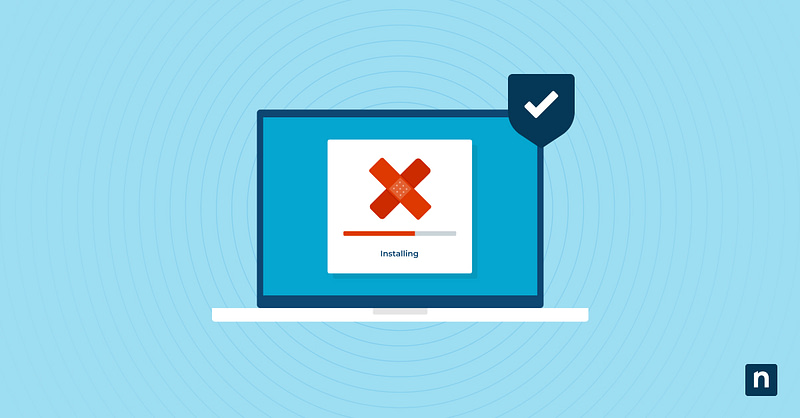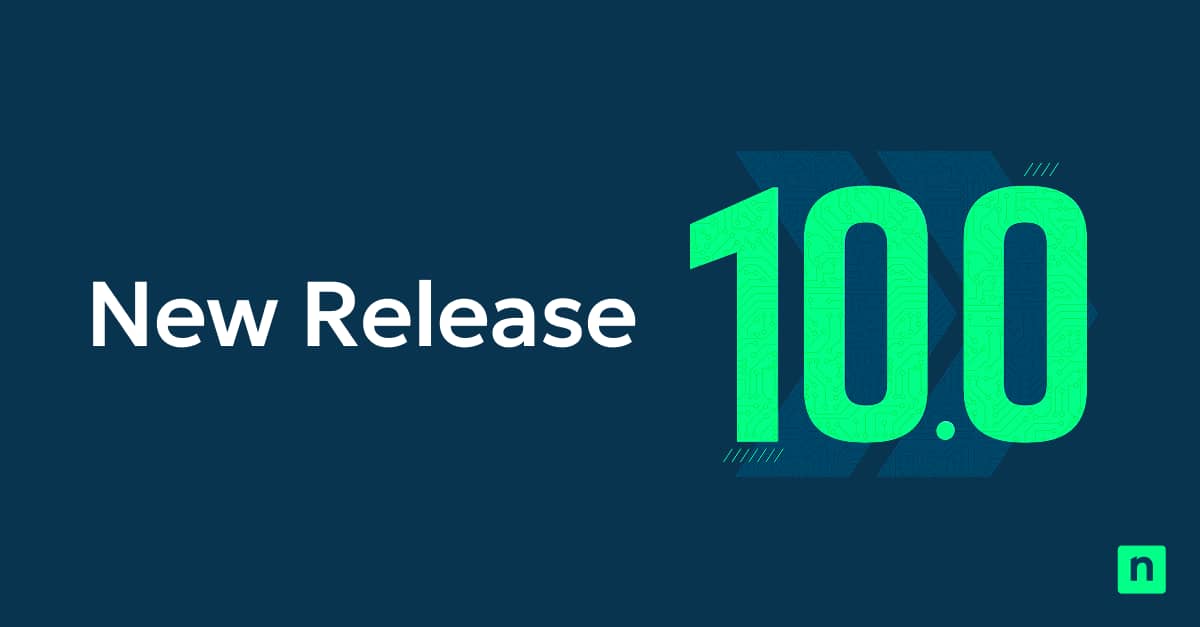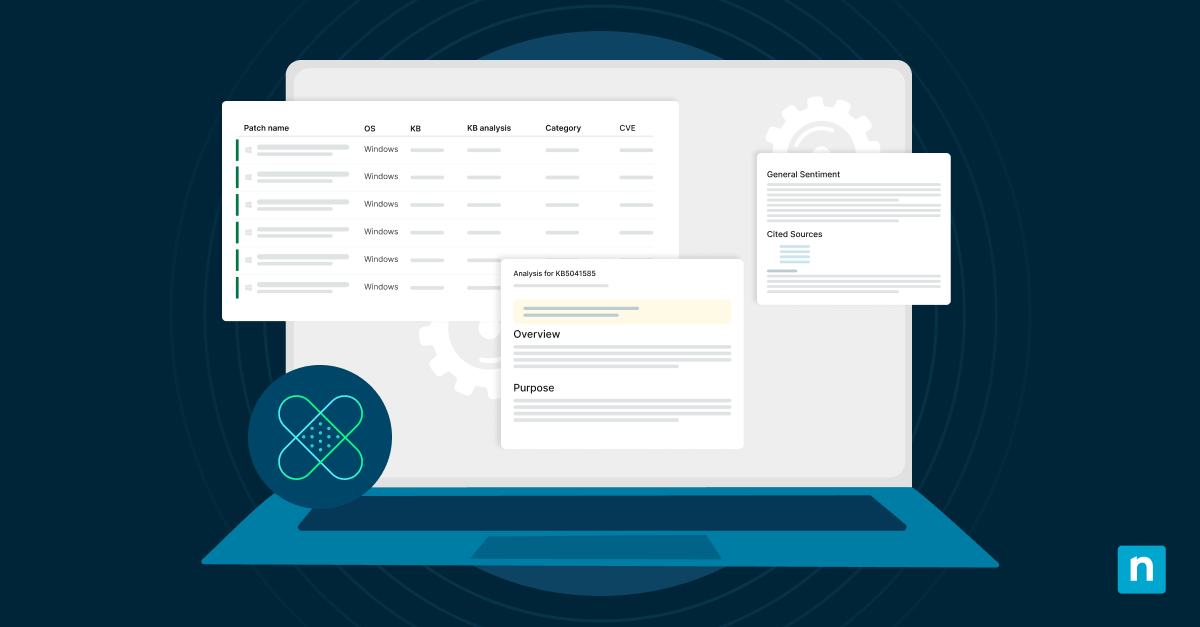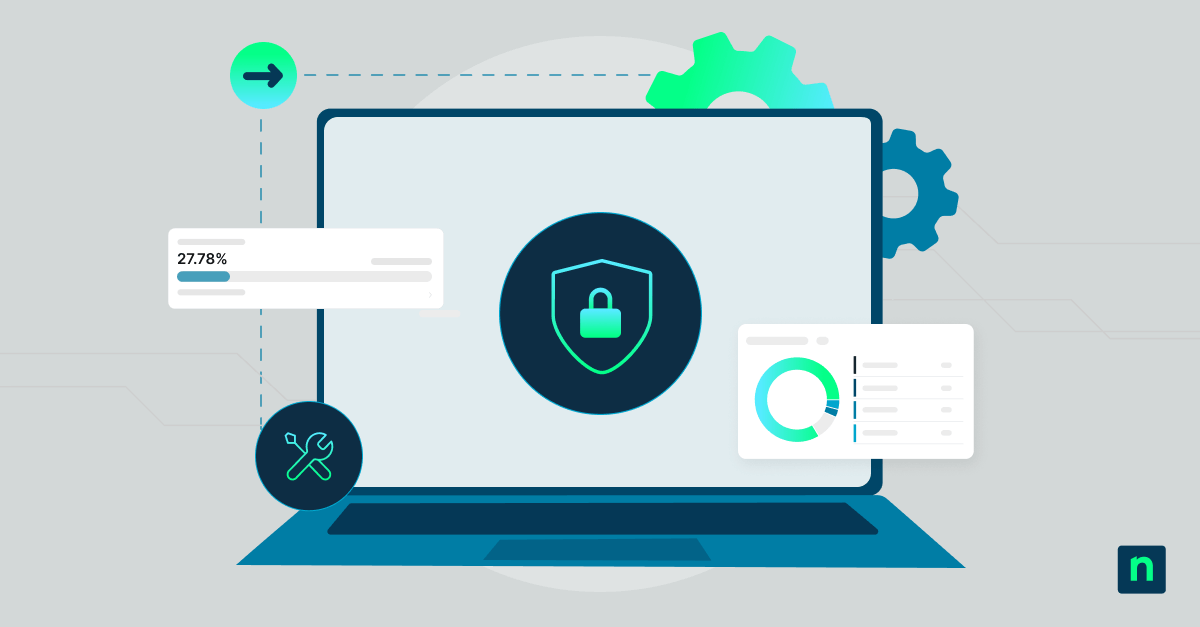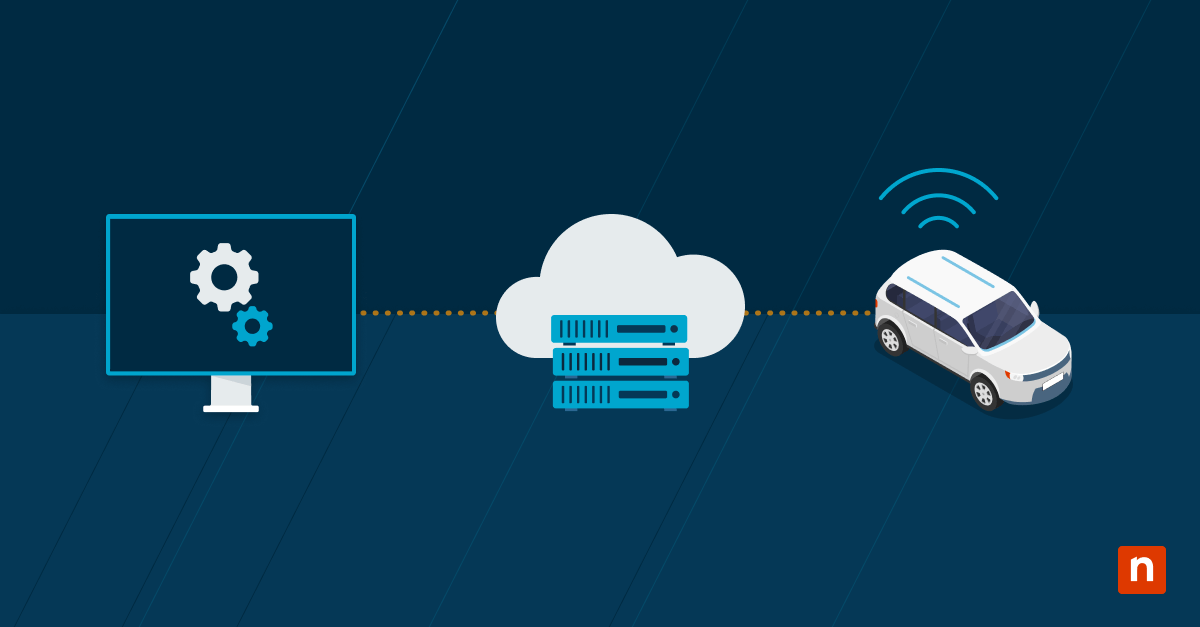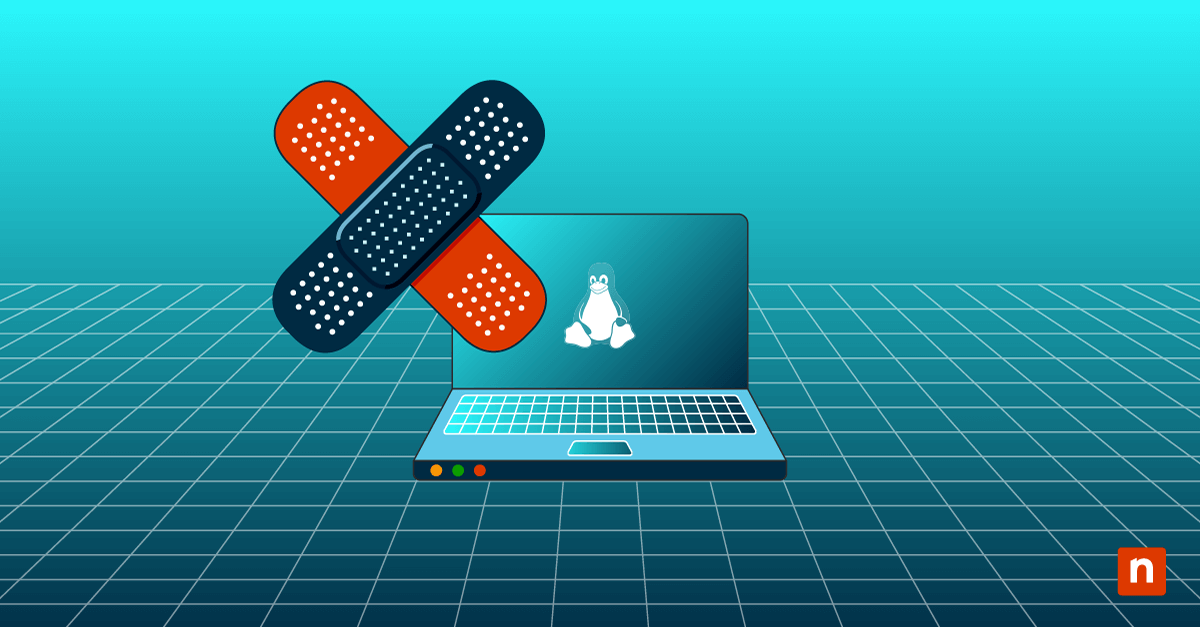Since the number of malware attacks continues to rise every year, effective patch management is more important now than ever before. A Market Data Forecast report on the patch management industry claims that “the global patch management market size is forecasted to grow USD 1084 million by 2027 from 652 million USD in 2022, growing at a CAGR of 10.7% between 2022 and 2027.” Learn more about patch management and its multiple benefits in this overview.
What is patch management?
Patch management is the process of creating, testing, and deploying software updates to various endpoints. These updates, also known as “patches,” improve the current software by fixing technical issues, tightening security, or releasing new features.
Automate your patching process and reduce manual workloads with NinjaOne.
What is a patch management process?
Patching can take a significant amount of time out of your day, especially if you have many IT assets to manage. A patch management process is a guide, or outline, that makes patching as simple as possible. Below, we’ll go over a basic patching process, but keep in mind that there are additional steps you should follow to create a complete patch management process.
💡Before diving in, check out our video on Patch Management Mistakes and How to Avoid Them to learn what pitfalls to avoid.
- Identification
The first step in a patch management process is to identify and gather an inventory of all the IT assets. This includes servers, desktops, laptops, routers, storage, and anything else on the network. You can identify and gather inventory manually or use a discovery tool. - Organization
After gathering inventory, the next step in the patch management process is to organize the assets into risk and priority categories. Instead of attempting to fix all issues with one policy, you can create more effective policies and tackle the most problematic issues first. - Policy creation
A patch management policy allows you to set up and schedule patching for your systems. If you know how to create a patch management policy, then you are already familiar with this step. When building a policy, you will determine the type of patching that is required, the time and date that the patching will occur, and the conditions that must be met before proceeding with the patching process. - Testing
With a test lab environment or segment, you can monitor patch performance and ensure that all your changes deploy successfully. Accurate testing prevents unforeseen issues from slipping past you and negatively affecting the patching process. - Documentation
The best way to keep track of software changes, or patches, is to document them. Additionally, documentation will come in handy if any issues arise after the final patch deployment. - Patch release and audit
Now it’s time to release the patch policies that you created from step three. After completing the patch release, conduct a patch management audit to identify failures or performance issues.
Why patching is important
Patch management is a layer of security that allows IT administrators, security teams, users, and organizations to protect their managed systems from cyberattacks and other harmful threats. Patches such as “software patches”, “OS patches,” “firmware updates,” and more help secure IT systems by making them less susceptible to vulnerabilities. The absence of employing a patch management strategy may lead to risks such as software malfunctions, disruptive downtimes, and even compliance violations. The vulnerabilities caused by unpatched systems may even result in unwanted infiltration from attackers.
Additionally, operating system patching is particularly critical, as unpatched systems can become easy targets for cybercriminals. Setups such as remote work, hybrid workforce, and Bring Your Own Device environments may be affected by unpatched vulnerabilities. This only proves the value of patch management more than ever.
What are the benefits of patch management?
Safety
One of the main goals of patching is to identify and fix security vulnerabilities within a system. Effective patch management will prevent cyberattacks and malware from harming your business.
Innovation
To grow and rise above competitors, businesses need to improve the services that they offer. Patch management allows you to add new features or upgrades to your service to improve the user experience.
Compliance
Today, there are multiple cybersecurity standards that businesses follow to keep themselves safe. To comply with these standards, a business will need a patch management system.
Efficiency
In the world of business, time is money. A patch management system automates the patching process to make it faster and more efficient.
What is patch management software?
Patch management software automates the patching process to make it faster and more efficient. With reliable patch management software, MSPs and internal IT will spend only a few minutes on patching instead of multiple days. The key functions that patch management software provides include:
Automation
Automation reduces the need for human intervention. With patch management software, you can identify, download, and deploy OS and application patches without manual effort.
Reporting
Effective patch management solutions gather and consolidate key data on a single pane of glass, making reporting streamlined. With all the necessary information readily available, generating reports on security vulnerabilities, patch compliance, and patch deployments becomes a simple process.
Visibility
Clear visibility is essential for monitoring and controlling operating systems. Patch management software provides complete visibility into your entire IT portfolio.
Remediation
Remediation processes ensure the security of operating systems and endpoints. Patch management software identifies and fixes issues to return systems to normal.
How patch management software works
Patch management and the procedures that mitigate how patching works involve intricate processes that typically follow the following steps:
- Discovery: IT teams or patch management tools identify devices and software that require updates.
- Assessment: Potential vulnerabilities and software bugs are analyzed to determine patching priorities.
- Testing: Before deployment, patches are tested in a controlled environment to ensure they do not cause disruptions.
- Deployment: Approved patches are rolled out to all relevant endpoints.
- Verification: Post-deployment checks ensure the patch was successfully applied.
- Reporting: Detailed reports track compliance and the overall patching status across the organization.
Manage patches across Windows, macOS, and Linux seamlessly.
Types of patch management software
There are multiple types, or categories, of patch management software on the market. Some common types of patch management software are:
1. Automated patch management
Automated patch management software performs patching and other functions automatically, without human intervention. It’s efficient, easy to use, and gets the job done quickly.
2. Open-source patch management
Open-source patch management software is “free” software that is available for all to use. The drawback of open-source patching software is that it tends to be limited to the most basic functions and does not always support scalability.
3. Cloud-based patch management
Cloud-based patch management software allows you to patch on- and off-network devices. Cloud-based software is essential for businesses that operate with a partly or fully remote workforce.
Examples of patch management
Patch management may come in different forms of actions that are significant to the protection of IT systems. These actions may include the following:
- Operating system patching: Major operating systems push out essential updates to devices. Microsoft regularly releases “Patch Tuesday” updates to address Windows vulnerabilities. Meanwhile, macOS occasionally releases security updates, bug fixes, and updates to apps that come with the Mac.
- Third-party applications: Apps installed on devices receive updates through different platforms. Some get their software patches directly from the application store from where they were downloaded, such as the Google Play Store for Android devices and the App Store for devices running on iOS and iPadOS.
Other third-party applications may receive updates online from their respective developer sites. These updates may include software patches essential for maintaining software security and functionality.
- Firmware updates: Devices like routers and IoT devices often require firmware patches to fix bugs or enhance security. These patches can be delivered from a designated server on the Internet and sent “over the Air” (OTA).
- Industry-specific software: Specialized systems are updated mainly for compliance. For example, Electronic Health Records (EHR) systems in healthcare must be patched to comply with HIPAA regulations.
By understanding these examples, it becomes clear what patches are in computer systems and why they are vital.
How to improve patch management
To improve your patch management process:
- Implement automation: IT administrators and security teams can leverage patch management software to automate updates. This allows for a more streamlined patch management process while reducing human intervention, saving time, and maximizing productivity.
- Conduct regular audits: Schedule a regular patch assessment to check your system to see if they’re up to date when it comes to protection from vulnerabilities and threats. Make this a frequent habit to ensure no device or application is left unpatched.
- Establish patch policies: Define a clear patch management policy for prioritizing and testing patches. Consider criteria such as the severity of impact on unpatched systems, possible downtimes, and the urgency of applying patches.
- Train your team: It’s vital for your IT team to be educated about the essence of applying patches in a timely manner. They should also have comprehensive training on tools for pushing patches, ensuring calibrated knowledge of patch management.
- Monitor patch success rates: A robust patch management software has reporting features that can measure the effectiveness of your patching strategy. Ensure that your IT team understands how to utilize this feature to shed light on the efficacy of your patch management strategies.
Best practices in patch management
Adopting patch management best practices ensures effective and consistent results:
- Prioritize critical updates: As mentioned in ways to improve patch management strategies, you should first focus on patches that address high-severity vulnerabilities. Effective vulnerability management can give you an idea of which endpoints are the most susceptible, so you can put them first in line for immediate patching.
- Test patches before deployment: Testing patches in a staging environment ensures that the updates you plan to deploy will do what they are supposed to and will not introduce more unwanted issues into the system.
- Schedule regular updates: Use your preferred patch management software to automate scheduled deployments of the patch management policy. Make it a habit to create a patching schedule plan to ensure updates occur consistently.
- Maintain an inventory of assets: A great IT management solution may offer a unified platform where you can simultaneously perform automated patch management and IT asset management. This can help you keep track of all hardware and software within a centralized platform, ensuring no systems are overlooked.
Stay informed. Subscribe to vendor notifications to stay updated on new patches and vulnerabilities. Most of these updates highlight the importance of patching in cybersecurity and enhancements in IT system performance.
How to choose a patch management solution
There are many patch management software options, and each software comes with specific features. To choose a patch management software for your IT department, consider the features or benefits you expect from your software. For instance, the patch management software from NinjaOne is fast, scalable, and easy to use.
With patch management software from NinjaOne, you can automate patching, secure all endpoints, and gain visibility into your entire IT portfolio. If these features sound like a great fit for your IT department, then patch management software from NinjaOne is an excellent choice.
Patch Management as a Service (PMaaS)
Patch Management as a Service (PMaaS) is a solution offered by organizations to lessen the impact of patching tasks on over-burdened IT teams. Businesses can choose from multiple vendors and eliminate the hassle of patch management by taking care of the function automatically using the as-a-Service model.
While patch management is critical to an IT team’s success, with the buildup of responsibility, it can often be overlooked. NinjaOne offers patch management solutions for Windows, macOS, Linux, and more to help your overburdened IT team.
Conclusion
With every passing year, internal IT departments and MSPs rely more and more on patch management software to keep their systems running smoothly. From creating policies to deploying patches, patch management software can automate numerous tasks to make patching quicker and easier. Nobody can ever discount the significance of patching in cybersecurity and other aspects of IT system protection.
To learn more about patch management and what it entails, explore our patch management best practices guide. At NinjaOne, we are proud to offer the best patch management software on the market. Sign up for a free trial today, and see for yourself how you can benefit from using NinjaOne.
Enhance your IT infrastructure’s security and efficiency with robust patch management tools.
Start a free trial of NinjaOne Patch Management
More patch management resources
- Patch Management Mistakes
- Patch Management Metrics
- Patch vs Update
- Vulnerability Prioritization
- How Much Does Patch Management Software Cost
- How to Patch Third-Party Applications
- What Is Windows Patch Management
- How to Automate Patch Management
- Patch Management Best Practices for Corporate IT
- How to Choose a Patch Management Solution
- Patch Management Best Practices Overview
- Patch Management Lifecycle
- Best Patch Management Software
- Open Source Patch Management

